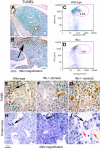Hypoxic stress underlies defects in erythroblast islands in the Rb-null mouse
- PMID: 17557897
- PMCID: PMC1976369
- DOI: 10.1182/blood-2007-01-069104
Hypoxic stress underlies defects in erythroblast islands in the Rb-null mouse
Abstract
Definitive erythropoiesis occurs in islands composed of a central macrophage in contact with differentiating erythroblasts. Erythroid maturation including enucleation can also occur in the absence of macrophages both in vivo and in vitro. We reported previously that loss of Rb induces cell-autonomous defects in red cell maturation under stress conditions, while other reports have suggested that the failure of Rb-null erythroblasts to enucleate is due to defects in associated macrophages. Here we show that erythropoietic islands are disrupted by hypoxic stress, such as occurs in the Rb-null fetal liver, that Rb(-/-) macrophages are competent for erythropoietic island formation in the absence of exogenous stress and that enucleation defects persist in Rb-null erythroblasts irrespective of macrophage function.
Figures






Similar articles
-
Retinoblastoma promotes definitive erythropoiesis by repressing Id2 in fetal liver macrophages.Nature. 2004 Dec 23;432(7020):1040-5. doi: 10.1038/nature03068. Nature. 2004. PMID: 15616565
-
The Rb tumor suppressor is required for stress erythropoiesis.EMBO J. 2004 Oct 27;23(21):4319-29. doi: 10.1038/sj.emboj.7600432. Epub 2004 Sep 30. EMBO J. 2004. PMID: 15457215 Free PMC article.
-
Absence of erythroblast macrophage protein (Emp) leads to failure of erythroblast nuclear extrusion.J Biol Chem. 2006 Jul 21;281(29):20181-9. doi: 10.1074/jbc.M603226200. Epub 2006 May 16. J Biol Chem. 2006. PMID: 16707498
-
Erythroblastic islands: specialized microenvironmental niches for erythropoiesis.Curr Opin Hematol. 2006 May;13(3):137-41. doi: 10.1097/01.moh.0000219657.57915.30. Curr Opin Hematol. 2006. PMID: 16567955 Review.
-
Effects of hypoxia on heterotypic macrophage interactions.Cell Cycle. 2007 Nov 1;6(21):2620-4. doi: 10.4161/cc.6.21.4879. Epub 2007 Aug 13. Cell Cycle. 2007. PMID: 17873523 Free PMC article. Review.
Cited by
-
Making Blood: The Haematopoietic Niche throughout Ontogeny.Stem Cells Int. 2015;2015:571893. doi: 10.1155/2015/571893. Epub 2015 May 31. Stem Cells Int. 2015. PMID: 26113865 Free PMC article. Review.
-
Erythroblastic islands: niches for erythropoiesis.Blood. 2008 Aug 1;112(3):470-8. doi: 10.1182/blood-2008-03-077883. Blood. 2008. PMID: 18650462 Free PMC article. Review.
-
Discovery of genes essential for heme biosynthesis through large-scale gene expression analysis.Cell Metab. 2009 Aug;10(2):119-30. doi: 10.1016/j.cmet.2009.06.012. Cell Metab. 2009. PMID: 19656490 Free PMC article.
-
The embryonic origins of erythropoiesis in mammals.Blood. 2012 May 24;119(21):4828-37. doi: 10.1182/blood-2012-01-153486. Epub 2012 Feb 15. Blood. 2012. PMID: 22337720 Free PMC article. Review.
-
Biologic properties and enucleation of red blood cells from human embryonic stem cells.Blood. 2008 Dec 1;112(12):4475-84. doi: 10.1182/blood-2008-05-157198. Epub 2008 Aug 19. Blood. 2008. PMID: 18713948 Free PMC article.
References
-
- Bessis M. L'ilot erythroblastique: unite functionelle de la moelle osseuse. Rev Hematol. 1958;13:8–11. - PubMed
-
- Sadahira Y, Mori M. Role of the macrophage in erythropoiesis. Pathol Intl. 1999;49:841–848. - PubMed
-
- Chasis JA. Erythroblastic islands: specialized microenvironmental niches for erythropoiesis. Curr Opin Hematol. 2006;13:137–141. - PubMed
-
- Sasaki K, Iwatsuki H, Suda M, Itano C. Scavenger macrophages and central macrophages of erythroblastic islands in liver hematopoiesis of the fetal and early post-natal mouse: a semithin light- and electron-microscopic study. Acta Anat. 1993;147:75–82. - PubMed
-
- Hanspal M, Hanspal JS. The association of erythroblasts with macrophages promotes erythroid proliferation and maturation: a 30 kD heparin-binding protein is involved in this contact. Blood. 1994;84:3494–3504. - PubMed
Publication types
MeSH terms
Substances
Grants and funding
LinkOut - more resources
Full Text Sources
Molecular Biology Databases

